Camping Equipment
Items on this Page
Here we try to give you the benefit of our own experience of equipment that we use or have used as well seen others using.
The opinions expressed come from our experience and are not meant to promote a product positively or negatively.
As an Amazon Associate we earn money from qualifying purchases of any product shown here that links through to the Amazon pages. Such commissions do not affect the price that you pay to Amazon.
Camping - Tent
Tents
Our first touring tent was made by a small UK company based in Leeds, Lightwave. The specific model was the t2 trek xt. The current equivalent is the G20 Trek xt. The current version weighs only 2.89 Kilograms (6.35lbs)
complete. It is a tunnel design, two man tent with a spacious awning for
such a light package and head room in the awning of 1200mm (47 inches).
We used the tent on our Outer Hebrides trip and it stood up to a force 8 gale. It is a great tent for short tours.
For our round the World trip though we decided that, as we would be
spending so much time in our tent, we wanted something a little bigger,
even if it meant carrying more weight. Specifically we wanted a camping tent
that was robust, but high enough to allow us to actually sit on a stool
inside the tent. We researched the market and were tempted by the
Hilleberg range and the Wechsel range. Both offered tunnel tents with
higher profiles, but they attached an equally high profile price.
Finally we alighted upon the good old British standby, Vango.
The Equinox 350 is a roomy three man tent with a very generous head
clearance of 1350mm (53 inches) and weighing only 5.3kg (11.66lbs). OK
it's nearly double the weight of our last tent, but hey we are getting
old and need a bit of comfort at least - even if it does mean harder
pedaling.
What has been our experience of it so far? Broadly speaking very good.
Despite its height, the internal stays give it good rigidity and it is
still quite stable in high winds. There a few issues with it. Firstly
due to its larger footprint, it is more difficult to find a good flat
pitch and this does not suit it to wild camping very well. It is not
very tolerant of being pitched on anything other than flat ground. There
is also quite a large gap between the ground the edge of the fly sheet,
which can make it very draughty.
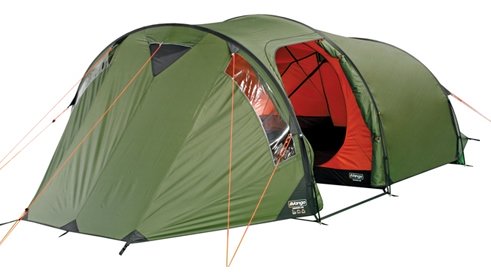
On cold nights it suffers from condensation on the inside of the fly
sheet, which drips onto the inner tent. However we have found that this
is a common problem with every man made fibre tent we have seen. When
there is also dew on the outside, it means you are packing a soaking wet
tent. This is no good when you have to pitch later in the day.
The door zips on the fly sheet tend to jam due to the fabric getting
caught in the zip, which is an annoying inconvenience. Another annoyance
is that when there is water on the outside of the tent and you undo the
fly sheet zip water drips onto the ground sheet in the tent awning.
All of these are minor inconveniences and to date we have yet to find a tunnel tent that doesn't suffer the same problems.
The following year, we decided that we could do with a smaller camping tent.
This would allow us more flexibility for wild camping and would save us
some weight. We researched the market and yet again came back to Vango
which offered the best value for money.
We chose the Spirit 300+. It is a tunnel tent and uses poles that are
connected and angled slightly at the apex. This means that you still
get a generous 110mm head height. Otherwise the construction is similar
to the Equinox 350.
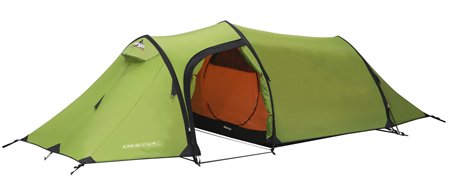
During 2010/2011 we camped in this tent almost everyday for 7 months,
and it took everything that we could throw at it. We had a slight
problem with the zip pull opening up slightly resulting in the zip not
properly meshing coming open. This could be resolved by carefully
crimping the puller with a pair of pliers.
As with much of our gear, the effects of UV on the tent were noticeable.
Particularly where the poles threaded through. The fabric became thin
and worn, resulting in the pole going through the fabric easily. This
just required more care. We also broke a pole due to carelessness.
We will be replacing our tent again this year and would like to go for
the new Vango Titan 300. This has a lower skirt around the base to stop
draughts and has three door entries compared to the one on the Spirit
range. However, it is nearly double the price so we may have to stick
with the Spirit.
Groundsheet
The ground sheet that Vango sell for the Equinox 350 is very heavy.
Almost as much as the tent again, so we looked for an alternative. There
appeared to be two suitable ground sheet materials in the blogs that
people were talking about. One was Silicon Impregnated Nylon (SilNylon)
and the other was a plastic material. SilNylon is nice and flexible,
easy to work with and does not make any noise when you move around on
it. However the material that we were using was not 100 percent
waterproof. The other material however is 100 percent waterproof, very
light but also very noisy when you move around on it.
We decided that we could probably put up with the ground sheet not being
quite waterproof. We bought a couple of lengths of the material and
made our own ground sheet. However, several weeks of camping in wet UK
conditions showed us that the ground sheet was not really waterproof
enough. Several times we woke up to puddles on the ground sheet. Before
we left the UK we looked for an alternative. We found a material in a
local army surplus store in Plymouth. It weighs about the same as the
SilNylon, but has proved to be 100% waterproof. It is a little more
noisy and quite slippery as it has a waxy feel to it. So we bought three
lengths and over the winter we will make it up into a ground sheet to
fit the tent. We are not sure what the material actually was.
This ground sheet worked well and lasted right through until we reached
Tasmania which was again a very wet area. On our first really wet night
it was clear that the waterproofing had broken down again. This time we
bought a bog standard PVC ground sheet at a local hardware store, cut it
to size and it worked fine.
We have come to the conclusion that it is not worth spending a lot of
money on special materials, as the wear and tear they suffer causes the
waterproofing to breakdown. The best idea is to just buy a cheap PVC
replacement when you need one.
Camping - Cooking
Stove
As we would be travelling through some remote spots, where getting gas
cylinders may prove difficult, we decided to go for a multi-fuel camping stove.
Again, having researched the market we chose the Primus Omnifuel stove.
It is light and compared to some of the high speed, high altitude
stoves it is relatively controllable. We do like to cook reasonable food
rather than just eating pot-noodles or soup, so some control of the
stove burner is necessary.
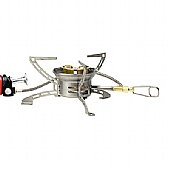
As standard the camping stove comes with two different jets enabling use of Gas,
White Fuel and Petrol. We have been pleased with the use of fuel and
the speed of cooking. It's as good as the old Primus stove that I used
as a lad when I used to go camping. Getting petrol proved to be
problematical only in the UK. The major service station chains and
supermarkets only allow a minimum delivery of 2 litres and even then
some will not allow you to fill anything other than their approved
containers, the Primus bottle not being one. Unfortunately, the UK is
full of "jobs worths" like this, everywhere else it isn’t a problem at
all.
Our camping stove is still going strong after four years of regular use. A word
of warning when travelling by air or sea. We had our fuel bottle
confiscated at Christchurch airport as we hadn't thoroughly washed it
out. getting on board the Melbourne to Tasmania ferry, they were
stopping and searching for fuel / gas bottles, so we had to empty and
wash the fuel out.
Cooking Pans
We have not been impressed by any of the pan sets we have seen. They are
generally made for backpackers who just want to boil water or cook pot
noodles, or so it seems. Believe it or not, you manufacturers out there,
bicycle tourists actually do want to eat reasonable food and therefore
need a decent set of pans. In the end we opted for the MSR Blacklite
set, which has a frying pan, one small and one large saucepan. They are
aluminium, about 2mm thick and Teflon coated. As with most non-stick
pans, the coating is wearing off, particularly around the rims, where
the clamp handle fits. I mean, which bright engineer at MSR designs a
pan with Teflon coating up to the rim and then designs a clamp handle to
scratch it off again? Duh!
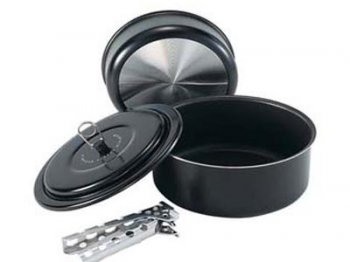
Three years down the line and we are still using our battered, Teflon
uncoated pans, having found nothing any better and being reluctant to
spend good money on a compromise product, (which most pan sets seem to
be).
It is amazing what culinary delights we manage to serve up using just three pans.
Camp Kitchen
To accompany our MSR pans we bought the MSR Camp Kitchen it comes with 1 x 3-ounce plastic bottles, 2 x 2-ounce plastic bottle, 1 x 0.75-ounce plastic bottles, 1 x 0.75-ounce squeeze bottle, 1 x 1-ounce squeeze bottle, Scrub pad, Plastic cutting board, Salt and pepper shaker, 3 x Ziplock bags, nylon zippered pouch, plastic organizer bowl and a lid.
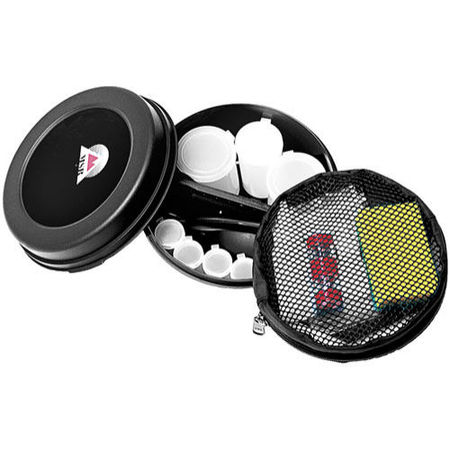
There is also a really useful folding utensil set which can also be purchased separately. The whole weighs just 15 oz/425 g. The plastic organizer bowl and lid also double as useful bowls for food preparation.
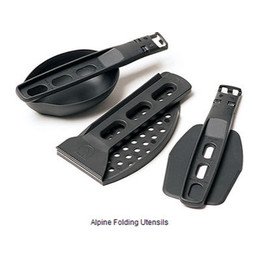
Cutlery
Do you hate those plastic knives and forks like we do and steel ones are so heavy. Try the same ones that we use, Lifeventure titanium. The weigh in at just 55g and measure at 190 x 50 x 20 mm. Each set comes in its own protective cover. These are great products. They last forever, but keep your eye on them. They are very desirable.
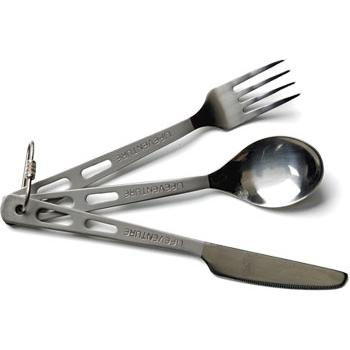
Camping - Sleeping
Its really important to be able to sleep well, particularly as you get older. So the selection of good quality sleeping bags and mats is important and worth paying a bit more for the best.
Sleeping Bags
With down sleeping bags you run the risk that if they get wet they are
useless and take forever to dry out again, but they are the lightest,
warmest and most comfortable sleeping bags money can buy. In our view it
is better to buy good quality down sleeping bags that pack up small and
light and take extra precautions to keep them dry.
After researching the market we chose Cumulus a small specialist
manufacturer from Altrincham, Cheshire in the UK. They have been
producing high quality outdoor equipment for over 18 years. Their down
filled sleeping bags and jackets have been tested during extreme
climbing expeditions in the Himalayas, Andes, Alps, Pamir and Atlas
mountains. We were not planning to go to those extremes, but we still
wanted something that was light, warm and comfortable.
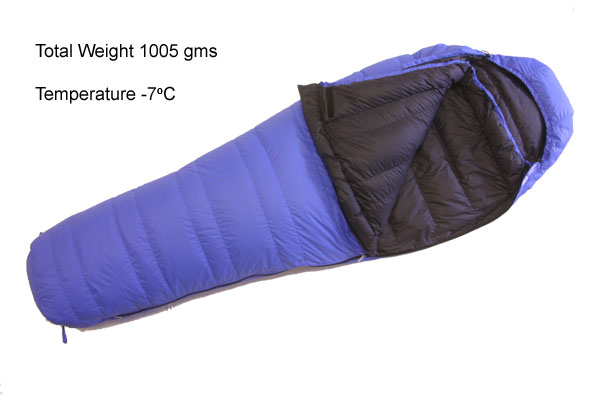
We opted for Cumulus' three season sleeping bag, the Mysterious
Traveller 500. These are specified down to -7° and weigh in at just a
little over 1 kilogram.
They also pack down nice and small. We protect them during travelling by packing them in Lifeventure roll top bags.
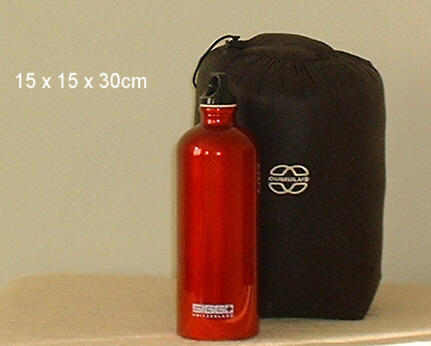
Sleeping Bag Liners
There are a number of different sleeping bag liners on the market and this link gives a summary of some of the key ones.
We chose the Lifeventure liners made from 100% silk, these luxurious sleepers are compact, light and
comfortable to use. They can be used on their own as an ultra light
travel sleeping bag in warm climates or as a liner to a sleeping bag.
This specific liner has the added benefit of Lifeventure's EX3
treatment, which provides some protection to the build up of
bacteria, acts as a barrier to bed bugs as well as containing a
mosquito repellent.
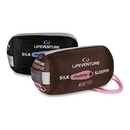
When its too warm not scorchio, we put our sleeping mats inside the liner and use it as an outer sheet. We then unzip our sleeping bags and use them like a duvet on the top.
Mattresses
A good sleeping bag is only as good as the mat that lies underneath it.
When you mention to people that you camp and sleep on an "air bed", they
look at you like you have just arrived from another planet. Li-lo™ is
to air beds as Hoover™ is to vacuum cleaners. The Li-lo was developed
for the military during the 1930s by Stefan Mangold and despite the name
being adopted by many as a general term for air beds, it is still a
registered brand.
Air beds or air mattresses have come on a long way since those early
days,and today there are numerous companies making a range of types,
including foam, self inflating, and pump inflating. For travelling by
bicycle weight, pack size, comfort, durability and ease of deployment
and packing are all key factors.
Following their recommendation, we bought our original mattresses from a
small family run outdoor shop, Crag and Moor in Scarborough, North
Yorkshire. They said that the Artiach Skin Mat was by far the best on
the market for both performance and weight. We trusted their judgement
and those mats lasted us well over 5 years.
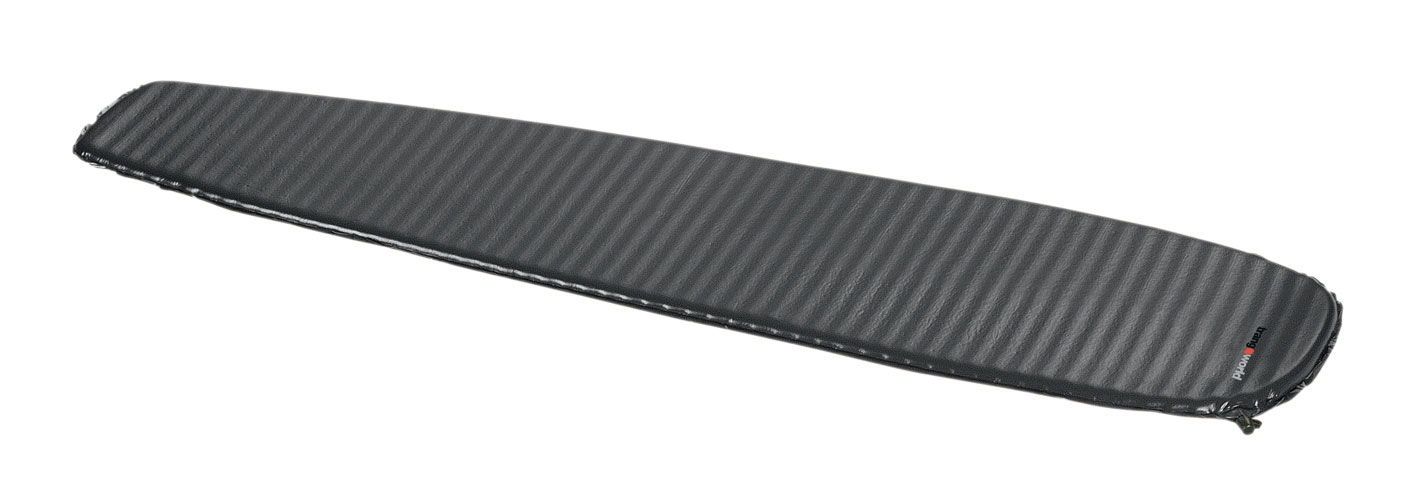
Artiach was taken over by the Spanish company Trango a few years ago. Trango have re branded the mats which are now sold as the TrangoWorld Skin Micro Lite. They come in mummy or rectangular and in short or full length. The great thing abut them is that they are very warm, only about 25mm thick when inflated and weigh only 540 grams.
They pack down small as well.
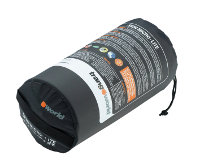
Whilst in Australia our warm and comfy Skin Lite beds suddenly started
to develop a bulge in the middle of the main body area, one first then
the other. The outer skin was separating from inner foam material. The
bulge got bigger until we realised that we would have to replace them.
Despite this problem, we liked them so much that we wanted to buy the
same again, but couldn't find any dealers in Melbourne.
So a change was necessary. Again lightness and small size were
important. We looked at Thermorest™ and others before choosing what some
might feel is more like the traditional Li-lo™. Our selection was the
Ultra light air mattress from the Swiss company Exped.
The Synmat 7UL is filled with synthetic fibre making comfortable, warm
and lightweight. The mats pack down small thanks to the highly
compressible microfibre.

- Size (cm) 183 x 52 x 7
- Weight (g) 460 +9 sack
- Packed (cm) 24 x 9.5
- Warmth ° C -4
- R-Value 3.1
Camping - Other Items
As we planned to spend a lot of time in our tent, we bought two
lightweight, three legged stools and a small aluminium folding table. It
does help to have a level surface on which to place things.
We also bought an Ortlieb folding wash bowl and collapsible water carrier.
We use a small LED lantern powered by four AAA batteries for light.
New! Comments
Have your say about what you just read! Leave me a comment in the box below.